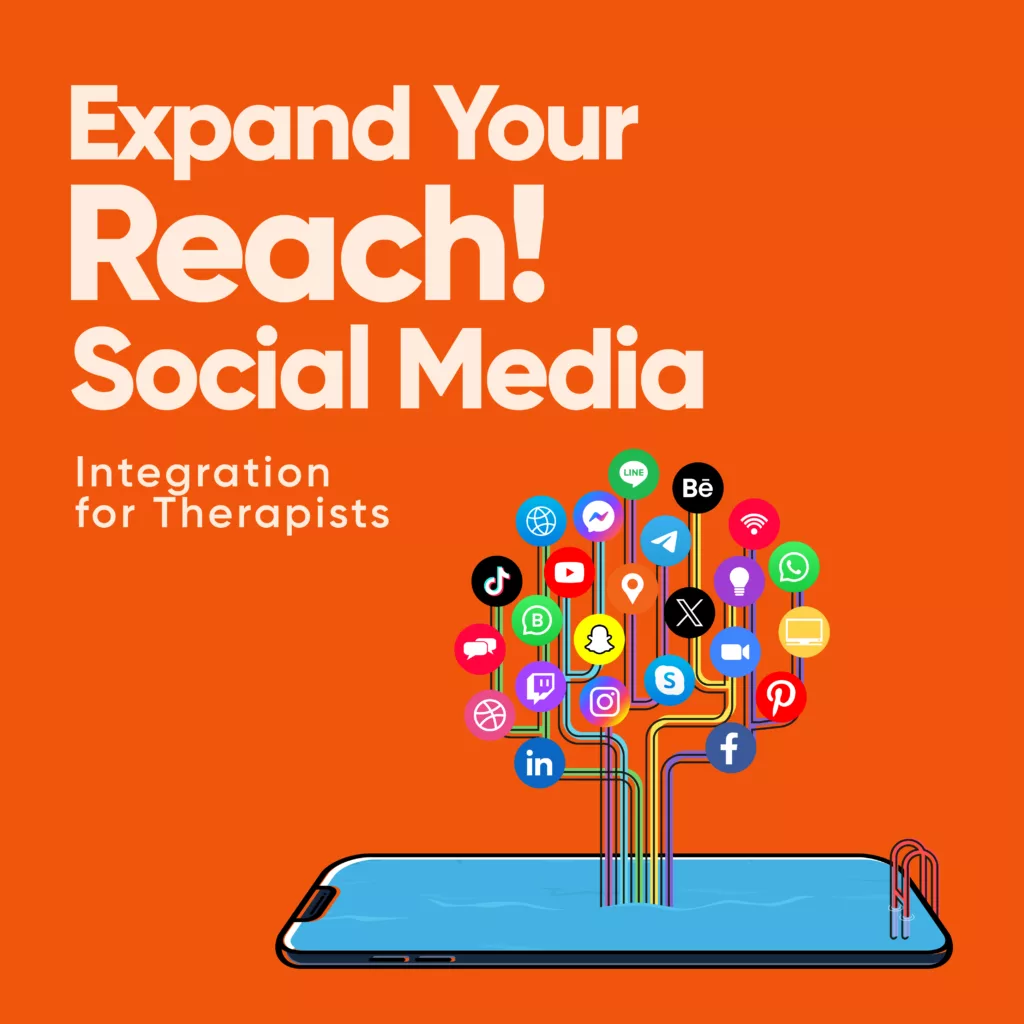Expand Your Reach: Website with Social Media Integration for Therapists

As a therapist, you’re dedicated to helping people overcome life’s challenges, but to truly make a difference, you need to be where your potential clients are.
In today’s digital age, that place is often on social media.
This blog is all about delving into the world of social media integration for therapist websites. We’re going to discuss the perks, discover the top platforms, master content strategies, define your unique personal brand, and sail through the legal and ethical bits.
So, let’s get started!

Benefits of a Website with Social Media Integration for Therapists
Social media integration for therapist websites can transform your practice by enhancing your online presence.
As therapists, we want to connect with clients in need, and here are some compelling reasons to harness the power of social media:
Increasing Visibility and Brand Awareness: Your potential clients are out there, and social media is where they spend a significant part of their time. By establishing a presence on these platforms, you become more visible, and people begin to recognize your name and face.
Building Trust and Credibility: Sharing your expertise and insights on mental health topics can help establish you as a trusted authority. When clients see you sharing valuable information, they’re more likely to trust you. Social media in healthcare is also powerful for promoting awareness and sharing accurate health messages, as explained in this blog.
Enhancing Client Engagement: Social media offers a unique platform to engage with your clients. You can answer questions, provide support, and even create a sense of community among your clients.
Keeping Up with Technological Advancements: As technology evolves, so does the way we communicate. Integrating social media into your practice helps you stay relevant and reach a wider audience.
Expanding Your Network: Social media allows you to connect with other professionals, not just in the field of therapy, but also in related disciplines. Building a robust network can lead to referrals and collaborations.
Showcasing Your Personality: Your professional identity is not just about your qualifications and expertise; it’s also about who you are as a person. Social media lets you showcase your personality, which can attract clients who resonate with your values and character.
Staying Informed: By following relevant groups and accounts, you can stay informed about the latest developments in the world of therapy and mental health. This continuous learning keeps you updated and ensures you provide the best services to your clients.
Cost-Effective Marketing: Compared to traditional marketing methods, social media integration is a cost-effective way to reach your target audience. According to Investopedia, social media marketing allows two types of interaction: customer-to-customer and firm-to-customer. This means SMM can measure customer value not only through purchases but also through product referrals, unlike traditional marketing which primarily tracks purchases.
Global Reach: With social media, your reach is not limited by geographical boundaries. You can connect with clients from around the world, broadening your client base and enriching your therapeutic experiences.
Advocacy and Awareness: By using your social media platform for advocacy and raising awareness about mental health issues, you not only contribute to the greater good but also show your commitment to the field, which can be attractive to potential clients who value social responsibility.

Choosing the Right Social Media Platforms
To effectively integrate social media into your therapist’s website, it’s crucial to select the right platforms that align with your goals and target audience. Some popular platforms to consider include:
Facebook
This versatile platform boasts a broad and diverse user base. Therapists can leverage Facebook to share informative articles, host discussions on mental health topics, and create a sense of community among their clients.
For example, you can post articles about stress management, create support groups for specific issues like anxiety, or even share personal success stories of your clients (with their consent) to inspire others.
Instagram
Instagram is perfect for therapists who want to use visual content to engage their audience. You can share inspirational quotes, eye-catching graphics, and even short videos that convey important messages about mental health.
Consider creating and sharing infographics about coping strategies or mindfulness exercises. You can also use Instagram Stories to provide quick tips or showcase behind-the-scenes glimpses of your practice.
X
If you prefer sharing quick updates and engaging in real-time conversations, X is an excellent choice. It’s a platform that allows therapists to stay updated with the latest trends in the field.
You can participate in relevant X chats and use trending hashtags to join conversations about mental health. For instance, if there’s a trending hashtag related to self-care, you can share your insights on the topic, offering valuable advice to a broader audience.
As a professional networking platform, LinkedIn is an ideal choice for therapists looking to connect with colleagues, share their expertise, and network with potential clients. You can create and share articles on topics related to therapy and mental health.
Building a strong LinkedIn profile with detailed information about your professional background and accomplishments can help you gain credibility in the field. You can also join LinkedIn groups dedicated to mental health discussions and contribute valuable insights.
When choosing platforms, think about your target audience. Are they more likely to be on Facebook or Instagram? Tailor your choices to your niche and where your clients are most active.
Content Strategy for Website with Social Media Integration for Therapists
Creating compelling content is the cornerstone of effective social media integration for therapist websites. Here are some tips to help you craft a content strategy that resonates with your audience:
Types of Content: Variety is key to engaging your audience. Consider sharing a mix of content formats to keep your followers interested and coming back for more. For example:
- Articles: Share well-researched articles on mental health topics. If your niche is anxiety therapy, you could post articles about different anxiety disorders, coping mechanisms, or success stories of clients who’ve overcome anxiety.
- Infographics: Create eye-catching infographics that simplify complex concepts. For instance, design an infographic illustrating the steps of deep breathing exercises for stress relief. Visual content is highly shareable and can reach a broader audience.
- Videos: Use videos to deliver powerful messages. You could record short videos explaining mindfulness techniques or even conduct interviews with other experts in the field. For instance, create a video series where you answer common client questions.
- Personal Stories: Sharing your personal experiences, within the boundaries of professional ethics, can make you more relatable. For example, if you’re a therapist who specializes in helping clients deal with grief, you might share a personal story about how you coped with the loss of a loved one and tie it to strategies you’ve learned that can help clients.
Sharing Expertise: Providing valuable insights is a cornerstone of a successful content strategy. Share your knowledge on mental health topics, answer common questions, and offer practical tips for self-care. For example:
- Write articles or create videos that explain the science behind stress and anxiety, and provide actionable tips for managing them.
- Offer regular “Tip of the Week” posts where you share practical advice on coping with daily stress or improving mental well-being.
- Share case studies (with client consent and anonymity) that illustrate the progress and success your clients have achieved under your guidance.
Personal Touch: Building a personal connection with your audience is vital. While maintaining professional boundaries, sharing a bit of your personality and personal experiences can help your clients relate to you on a deeper level. For instance:
- Share a post on social media about a personal mindfulness practice that you find effective, and invite your followers to try it out.
- Celebrate personal and professional milestones. For instance, if you’ve recently completed additional training in a specific therapeutic approach, share your achievement and explain how it benefits your clients.
Content Calendar: Planning your content in advance is a smart strategy. A content calendar helps you stay organized and consistent, ensuring that you cover a wide range of relevant topics. For example:
- Plan to post articles related to specific mental health themes during Mental Health Awareness Month in May.
- Create a content schedule that includes a variety of content formats, such as infographics on Mondays, articles on Wednesdays, and other engaging content on Fridays.
- Schedule content in advance, so you can maintain a steady online presence, even during busy periods or vacations.
Engaging with Your Audience
Building a strong online presence isn’t just about posting content; it’s about actively engaging with your audience:
Responding to Comments and Messages: According to Helpscout, 83% of customers feel more loyal to brands that address their concerns. So, when clients comment on your posts or message you, replying promptly and thoughtfully helps build connections and offer support. For example:

- If a client comments on your post about coping with stress, you can reply with a personalized message like, “I’m glad you found this helpful! If you have any specific questions or need more guidance, feel free to send me a message.”
- Responding to direct messages promptly shows that you are accessible and attentive to your clients’ needs. If a client reaches out with a question about your services, provide a clear and informative response.
Q&A Sessions and Live Discussions: Hosting live Q&A sessions or discussions on platforms like Facebook or Instagram can foster a sense of community and provide real-time support. These sessions can be themed around various mental health topics. For instance:
- You can announce a live Q&A session on “Managing Anxiety” a week in advance, inviting your followers to submit their questions beforehand. During the session, address these questions in real-time, sharing your expertise and providing immediate guidance.
- Hosting live discussions on important mental health awareness days, such as World Mental Health Day, can draw a larger audience. For example, you might collaborate with another therapist and engage in a live discussion about the stigma surrounding mental health.
Professional Boundaries: While engaging with your audience is essential, maintaining professional boundaries is equally critical. It’s vital to strike a balance between being accessible and preserving the ethical guidelines of your profession. Examples of maintaining professional boundaries include:
- Avoiding direct therapeutic sessions or diagnosis online. If a follower shares personal concerns or asks for specific therapeutic advice, you can respond with a message like, “I appreciate your trust in me. Please reach out to me through the proper channels, and we can discuss your concerns in a secure and confidential environment.”
- Be cautious about sharing personal information. While it’s acceptable to share some personal experiences within ethical boundaries, refrain from divulging overly personal details that may compromise your professional image.
Legal and Ethical Considerations
While social media integration can be immensely beneficial, it’s crucial to navigate it with care, ensuring you uphold legal and ethical standards:
Maintaining Client Confidentiality: Client confidentiality is the bedrock of ethical therapeutic practice. It’s essential never to share any information that could potentially identify a client without their explicit and informed consent. Here’s how to maintain confidentiality:
- Case Studies: When sharing client success stories or case studies, always ensure that they are anonymized and that no identifiable information is included. Focus on the therapeutic process and outcomes, without revealing names, locations, or specific details.
- Private Messages: If you receive private messages from clients or prospective clients, take the conversation to a secure, HIPAA-compliant channel rather than discussing sensitive matters on public social media platforms.
Navigating HIPAA Compliance: The Health Insurance Portability and Accountability Act (HIPAA) sets stringent standards for the protection of patients’ medical information. It’s essential for therapists to become familiar with HIPAA guidelines and ensure their online interactions comply with them. Here’s how to navigate HIPAA compliance:
- Secure Communication: When discussing client-related matters, use secure and encrypted messaging platforms rather than open social media channels.
- Obtain Consent: Before discussing any client’s case, obtain written consent from the client that explicitly allows you to do so. Even with consent, avoid sharing detailed clinical information online.
Ensuring Ethical Behavior: Upholding the ethical guidelines of your profession is non-negotiable. Maintaining professionalism online is essential. Avoid making sweeping therapeutic claims, diagnosing individuals, or providing therapy via social media. Here’s how to ensure ethical behavior:
- Educational Content: Share educational content that helps clients better understand mental health, therapy, and available resources. Educate, rather than diagnose or treat.
- Avoid Conflicts of Interest: Be transparent about any conflicts of interest, such as financial ties to products or services you may promote. Always put your clients’ well-being first.
Disclaimers and Informed Consent: Use disclaimers to make it clear that your online presence is not a substitute for therapy. Your clients should understand the limitations of the support you can provide through social media. Here’s how to incorporate disclaimers and informed consent:
- Disclaimer Statements: Include a disclaimer in your social media profiles and posts stating that the content is for informational purposes only, and it should not be considered a substitute for professional therapy.
- Informed Consent: Ensure that clients provide informed consent before engaging in any online therapeutic interactions. They should understand the boundaries and limitations of such interactions and agree explicitly.
Therapists can integrate social media into their practice while maintaining client confidentiality and professional ethics by navigating legal and ethical considerations. It’s essential to strike a balance between leveraging the benefits of social media and safeguarding the well-being and privacy of clients.
Measuring and Analyzing Social Media Impact

To gauge the effectiveness of your social media integration, you need to track key performance indicators (KPIs) and adjust your strategy accordingly:
Tracking KPIs: Monitor metrics like the number of followers, engagement rate, website traffic from social media, and client inquiries resulting from your online presence.
Adjusting Your Strategy: Analyze the data and make changes to your content and posting schedule based on what works and what doesn’t.
Tools and Resources for Measurement: Utilize tools such as Google Analytics, social media insights, and third-party analytics tools to gather data.
Case Study
To illustrate the impact of social media integration, let’s delve into some real-life case studies:
- Success Stories: Explore stories of therapists who have effectively used social media to reach and help more clients.
- Lessons Learned: Learn from the experiences of others, including their challenges and how they overcame them.
Challenges and Pitfalls
While the benefits are numerous, there are also challenges and pitfalls to be aware of when integrating social media into your practice:
- Dealing with Negative Feedback or Trolls: Learn how to handle negative comments or interactions gracefully and professionally.
- Balancing Personal and Professional Use: Striking a balance between personal and professional use of social media can be tricky. Maintain boundaries to protect your privacy.
- Managing Time and Resources: Social media can be time-consuming. Find ways to manage your online presence without sacrificing your core therapeutic work.
Tips and Best Practices
To conclude, here are some tips and best practices to ensure a successful social media integration:
- Implement Security Measures: Protect your online presence with strong passwords and consider using two-factor authentication.
- Stay Updated: Keep abreast of changes in social media platforms’ algorithms and rules to ensure your content remains visible.
- Collaborate with Other Professionals: Partner with colleagues for joint initiatives and share each other’s content to broaden your reach.
- Self-Care and Avoiding Burnout: Lastly, take care of yourself. Social media integration can be demanding, so prioritize self-care to maintain your well-being.
Empower Your Reach, Illuminate Lives... and Make a Difference!
In the ever-evolving landscape of therapy and mental health support, social media integration for therapist websites is more than just a trend—it’s a powerful tool to expand your reach, connect with those in need, and make a meaningful impact.
Now, it’s your turn to seize the opportunity and take your practice to new heights. Social media integration can boost your brand’s visibility and credibility. It allows meaningful engagement with clients, expands your network, and advocates for mental health awareness. A positive step towards a strong digital presence.
But that’s not all. I understand that coming up with engaging content can be a challenge. So, to make it easier for you, I’ve prepared a month’s worth of engaging content prompts. With this guide, you’ll have one less thing to worry about on your social media journey.
If you want to explore low-cost social media tools to enhance your online presence, we have a dedicated blog for you. It’s titled “Low-cost Social Media Tools for Your Biz.”
Your presence on social media can be a beacon of hope and support for those seeking guidance and understanding. By taking these steps, you’re not only expanding your reach but also contributing to the greater good by making mental health resources more accessible.
The world of social media integration is a powerful tool in your mission to make a difference.
Related Reads for Driving Traffic/ Marketing Your Private Practice
- Therapy Business Tips: How to Drive Traffic to Blog for FREE
- Marketing for Therapists: How to be SEEN online
- Content Marketing for Therapists: The Ultimate Guide
- Website with Social Media Integration for Therapist Websites
- Drive Traffic to Your Website by Blogging
- Start Social Media Success with Low Cost Tools for Small Businesses
- Social Media Marketing for Therapists: Content Prompt Ideas
- 6 Smart Strategies for Marketing your Private Practice
- 7 Ways on How to Hook a Reader From Start to Finish
- Traffic but no sales or clients? Here are 5 Possible Reasons.
- Social Media For Therapists – Increasing Reach and Website Ranking
Need any of the following? Contact us!
Here are some Sample Websites We’ve Created:
- Non Profit Organization Website Design
- Examples Of Online Therapy Websites
- Group Practice Website Design
Check out our Portfolio for more!

